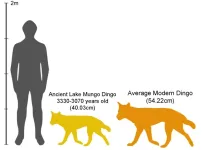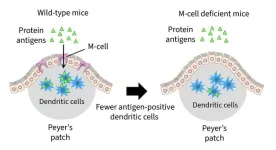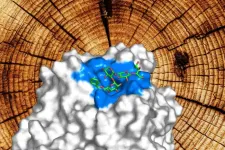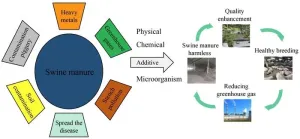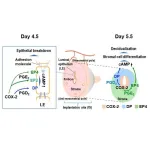Understanding changes in pre-clinical Alzheimer’s disease
Two disease-related proteins impact brain activity differently: From hyper- to hypoactivity to cognitive decline
2024-09-18
(Press-News.org)
Amyloid-beta and tau proteins have long been associated with Alzheimer’s disease. The pathological buildup of these proteins leads to cognitive decline in people with the disease. How it does that, though, remains poorly understood.
A new study from the labs of Sylvain Baillet at The Neuro and Sylvia Villeneuve at the Douglas Research Centre provides important insight into how these proteins impact brain activity and possibly contribute to cognitive decline.
The team led by Jonathan Gallego Rudolf, a Ph.D. candidate in Baillet and Villeneuve’s labs, recruited 104 people with a family history of Alzheimer’s. They scanned the participants’ brains using a combination of positron emission tomography (PET) to detect the presence and location of the proteins and magnetoencephalography (MEG) to record brain activity in these regions.
The scientists compared the results of the two scans and found that brain areas with increased levels of amyloid-beta showed macroscopic expressions of brain hyperactivity, reflected by increased fast- and decreased slow-frequency brain activity. For people with both amyloid-beta and tau in their brain, the pattern shifted towards hypoactivity, with higher levels of pathology leading to brain activity slowing.
Using cognitive tests, the team discovered that participants with higher rates of this amyloid-tau related brain slowing showed higher levels of decline in attention and memory.
The findings suggest that the interplay between amyloid-beta and tau lead to altered brain activity before noticeable cognitive symptoms appear. In a follow up study, Rudolf plans to rescan the same participants over time to prove whether the accumulation of the two proteins promotes further slowing of brain activity, and whether this accurately predicts the cognitive evolution of the participants.
“Our study provides direct evidence in humans for the hypothesized shift in neurophysiological activity, from neural hyper- to hypo-activity, and its association with longitudinal cognitive decline. These results parallel findings from animal and computational models and contribute to the advancement of our understanding of the pathological mechanisms underlying the preclinical stage of Alzheimer’s disease,” says Rudolf.
Their findings were published in a paper titled “Synergistic association of Aβ and tau pathology with cortical neurophysiology and cognitive decline in asymptomatic older adults” in the journal Nature Neuroscience on Sept. 18, 2024.
END
[Attachments] See images for this press release:
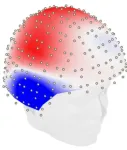

ELSE PRESS RELEASES FROM THIS DATE:
2024-09-18
UPTON, N.Y. — Scientists from the U.S. Department of Energy’s (DOE) Brookhaven National Laboratory have shown that a type of qubit whose architecture is more amenable to mass production can perform comparably to qubits currently dominating the field. With a series of mathematical analyses, the scientists have provided a roadmap for simpler qubit fabrication that enables robust and reliable manufacturing of these quantum computer building blocks.
This research was conducted as part of the Co-design Center for ...
2024-09-18
New archaeological research by the University of Sydney has discovered for the first time clear links between fossils of the iconic Australian dingo, and dogs from East Asia and New Guinea.
The remarkable findings suggest that the dingo came from East Asia via Melanesia, and challenges previous claims that it derived from pariah dogs of India or Thailand.
Previous studies used traditional morphometric analysis – which looks at the size and shape of the animal using callipers – ...
2024-09-18
The National Multiple Sclerosis Society (USA) has awarded a grant of 1 million dollars to Dr. Isabel Pérez-Otaño, who leads the Plasticity and Remodeling of Neural Circuits laboratory at the Institute for Neurosciences (IN), a joint center of the Spanish National Research Council (CSIC) and the Miguel Hernández University (UMH) of Elche. The grant is part of the NMSS 'Pathways to Cure' program that funds innovative therapeutic approaches to treat multiple sclerosis (MS). The team will work on identifying mechanisms that mediate a special kind of brain plasticity, known as myelin plasticity. The goal is to find ways to stimulate myelin plasticity ...
2024-09-18
[Strasbourg, 18th September 2024]
A new online tool designed to assess the equity of scholarly communication models is launched today at the OASPA 2024 conference. The “How Equitable Is It” tool, developed by a multi-stakeholder Working Group, comprising librarians, library consortia representatives, funders and publishers, and convened by cOAlition S, Jisc and PLOS, aims to provide a framework for evaluating scholarly communication models and arrangements on the axis of equity.
The tool, which was inspired by the “How Open Is It?” framework, is targeted at institutions, library consortia, ...
2024-09-18
Preschool teachers have different views on finger counting. Some teachers consider finger counting use in children to signal that they are struggling with math, while others associate its use as advanced numerical knowledge. In a new Child Development study, researchers at the University of Lausanne in Switzerland and Lea.fr, Editions Nathan in Paris, France, explored whether a finger counting strategy can help kindergarten-aged children solve arithmetic problems.
Adults rarely use their fingers to calculate a small sum (e.g., 3+2) as such behaviors could be attributed to pathological difficulties in mathematics or cognitive impairments. However, young children between ...
2024-09-18
Researchers led by Hiroshi Ohno at the RIKEN Center for Integrative medical sciences (IMS) in Japan have discovered that food antigens like milk proteins help keep tumors from growing in our guts, specifically the small intestines. Experiments revealed how these proteins trigger the intestinal immune system, allowing it to effectively stop the birth of new tumors. The study was published in the scientific journal Frontiers in Immunology on Sep. 18.
Food antigens get a lot of negative press because they are the source of allergic reactions to foods such as peanuts, shellfish, bread, eggs, and ...
2024-09-18
Researchers want to transform the natural and abundant resource wood into useful materials, and central to that is a molecular machine found in fungi that decomposes the complex raw material into its basic components. A Kobe University researcher and his team now were the first to come up with a test feed for the fungal molecular machine that allows them to observe its close-to-natural action, opening the door to improving it and to putting it to industrial application.
Biochemical engineers want to transform the abundant and renewable material wood into bioplastics, medically relevant chemicals, food additives or fuel. ...
2024-09-18
PHILADELPHIA – Today, the American Association for Cancer Research (AACR) released the 14th edition of its annual Cancer Progress Report. This comprehensive report provides the latest statistics on cancer incidence, mortality, and survivorship. It also outlines how basic, translational, and clinical cancer research and cancer-related population sciences—largely supported by federal investments in the National Institutes of Health (NIH), the National Cancer Institute (NCI), the U.S. Food and Drug Administration (FDA), and the Centers for Disease ...
2024-09-18
Most of the heavy metals in pig manure originate from feed additives, such as copper and zinc. When these heavy metals are introduced into agricultural soil, they can significantly increase the heavy metal content in crops, posing a threat to both the environment and human health. While pig manure is rich in nitrogen, an essential nutrient for crop growth, a substantial amount of nitrogen is lost in gaseous form during the composting process, impacting the quality of the compost. Moreover, this process results in the emission of ...
2024-09-18
A team from Kumamoto University has uncovered a new mechanism that could revolutionize infertility care by promoting embryo implantation. The discovery focuses on prostaglandin (PG) receptors in the uterus that enhance the critical process of decidualization, which is necessary for a successful pregnancy. This finding opens the door to developing new fertility treatments that target these receptors.
Prostaglandins are bioactive lipids known for their role in body’s response to injury by causing fever and pain, but they are also crucial in reproductive ...
LAST 30 PRESS RELEASES:
[Press-News.org] Understanding changes in pre-clinical Alzheimer’s disease
Two disease-related proteins impact brain activity differently: From hyper- to hypoactivity to cognitive decline



